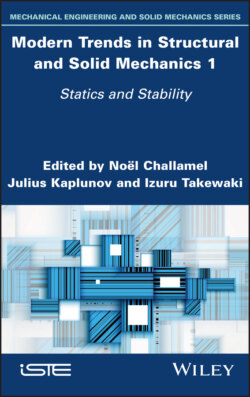Читать книгу Modern Trends in Structural and Solid Mechanics 1 - Группа авторов - Страница 18
1.3.2. Simply supported sandwich plate
ОглавлениеWe now study deformations of a sandwich plate with the top and bottom facesheets made of an orthotropic Aragonite crystal and the core made of a softer material. Material properties of the facesheets and the core are the same as those in Srinivas and Rao (1970). The top surface of the plate is loaded by sinusoidal tractions given by equation [1.12] and the bottom surface is traction-free. Since the load on the top surface given by equation [1.12] is different from that in Srinivas and Rao (1970), we first solved the problem analytically using their methodology, then verified our software by ensuring that values of displacements and stresses at several points agreed with those reported in Srinivas and Rao (1970). The thickness of each facesheet equals 0.1h and that of the core 0.8h, where h equals the sandwich plate thickness.
Defining β = Ex1/Ex2, where Ex1 and Ex2 are, respectively, elastic moduli of the facesheets and the core in the x direction, we compare the results from the least-squares method and the analytical solution for β = 1, 10, 100, 1000, 10,000, and aspect ratio a/h = 10, 5 and 2 in Tables 1.2–1.4. Quantities compared are the centroidal deflection, stresses σxx, σyy and σxz, normalized as wEx2/q0, σxx/q0, σyy/q0 and σxz/q0. Note that z = 0.4h+ and 0.4h-, respectively, represent interfaces between the top facesheet and the core. For the three aspect ratios and for all values of β except β = 10,000, the least-squares methodology gives results that differ from their analytical values by less than 0.4%. Even for β = 10,000, the maximum error in all quantities is less than 1.3%, except for that in σxz. Thus, we should not use the least-squares method for β = 10,000. We have not investigated if increasing values of N1, N2 and N3 in equation [1.9] will reduce this error.
For a/h = 2 and β = 1000, the error in the 15 variables listed in Table 1.4 was less than 1% for N1 = N2 = 6 and N3 = 4 (DOFs = 7,497) and less than 0.6% for N1 = N2 = 8 and N3 = 4 (DOFs = 12,393). Thus, the present method provides accurate values of the variables at critical points for a rather modest computational cost.
